Being a resident in the Canary Islands for over a decade, I never went on a boat trip to go whale and dolphin watching in Gran Canaria before. Having worked as a diving instructor around the world, and even as a divemaster on Gran Canaria in 2006, I always doubted if they see whales and dolphins in the waters of the Canary Islands. More than that, I always wondered if whale and dolphin watching on Gran Canaria in the form of a boat trip excursion is environmentally responsible.
So is the dolphin tour on Gran Canaria an eco-friendly excursion and sustainable activity that won’t harm marine life? Find this out in this post about the whale & dolphin watching cruise I finally did on Gran Canaria in 2024! I will also share about the different cetacean species that can be seen in the Canary Islands. And you can find some practical information with tips for your whale & dolphin watching boat tour on Gran Canaria, and how to do it in a way that respects marine life.
(ad)
How big is the chance to see dolphins and whales in the waters of Gran Canaria?
The chance to see a dolphin is big, and they see dolphins most days. To spot a whale, however, you’ve got to be lucky. Before I go deeper into the questions in the first paragraph, you can watch the little video above about the boat trip excursion of whale & dolphin watching Gran Canaria. The video already answers the first question that indeed you can see whales and dolphins in the waters around Gran Canaria. In this post, I will also describe in more detail the different whale and dolphin species that can be seen.
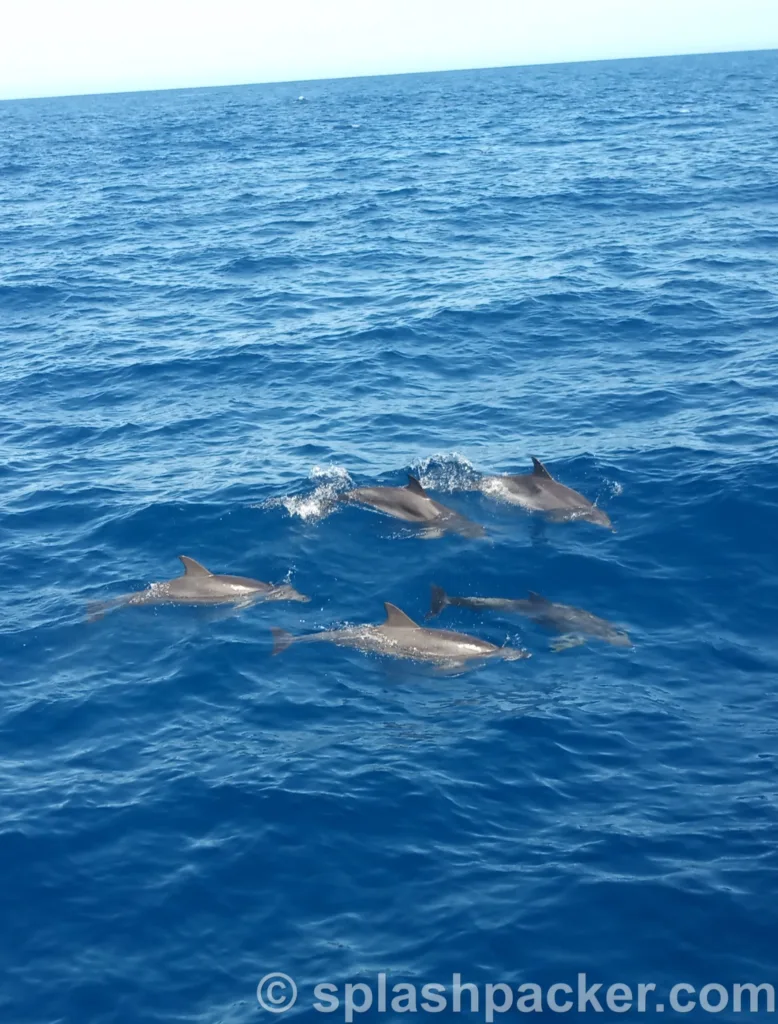
A dolphin guarantee for your dolphin watching cruise on Gran Canaria: a second ticket for free!
We saw many dolphins, and even a whale in the distance, during our dolphin watching cruise on Gran Canaria. But you can never be sure. Some companies, however, offer you another boat trip, free of charge, if you don’t get to see any dolphins or whales on your first dolphin tour. I’ve picked two whale and dolphin watching boats that offer the ‘dolphin guaranteed’ excursion on Gran Canaria. My pick was based on their ethical values of respecting and protecting marine life (more about that later). So check them out here (ad):
Dolphin watching on Gran Canaria in an eco-responsible way!
In this blogpost, I will share information about the different kinds of dolphins and whales you can see, before sharing more practical information about dolphin watching on Gran Canaria. There’s a variety of boats and catamarans that offer the dolphin watching trip on Gran Canaria (ad), and I will answer the most common questions for you. And, last but not least, how to make sure that you don’t disturb the animals, and what to look for to book the dolphin excursion with a responsible dolphin boat company.
So even as someone who likes to support sustainable tourism and prefers doing environmentally friendly activities, you can still go whale and dolphin watching on Gran Canaria! And by the way, you might also like to go scuba diving on Gran Canaria.
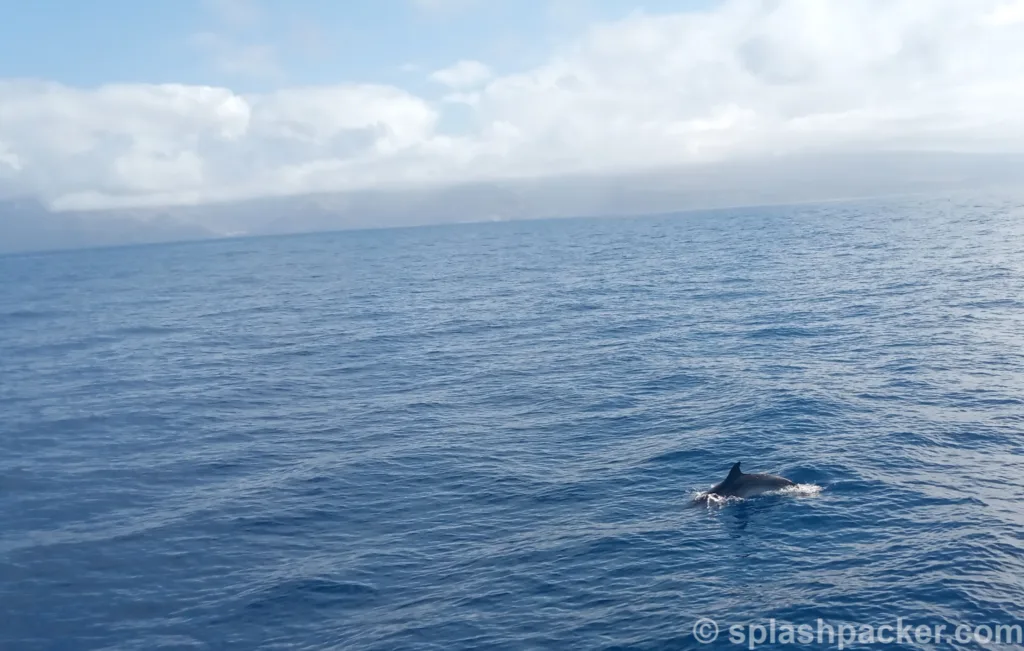
Are there whale & dolphin species in the waters of the Canary Islands?
Oh yes, there are many dolphins and also whales to be found around Gran Canaria! In fact, there are about 30 species of cetaceans to be found in the waters of the Canary Islands. This makes it the most diverse amount of species to be found in Europe. The water temperature, between 19°C (66,2°F) in winter and 24°C (73,4°F) in summer is ideal. With depths up to 3000 meters (roughly 9800 feet) in the Atlantic Ocean, in which the volcanic origin islands are located, the waters of the Canary Islands are a very good place for whales and dolphins.
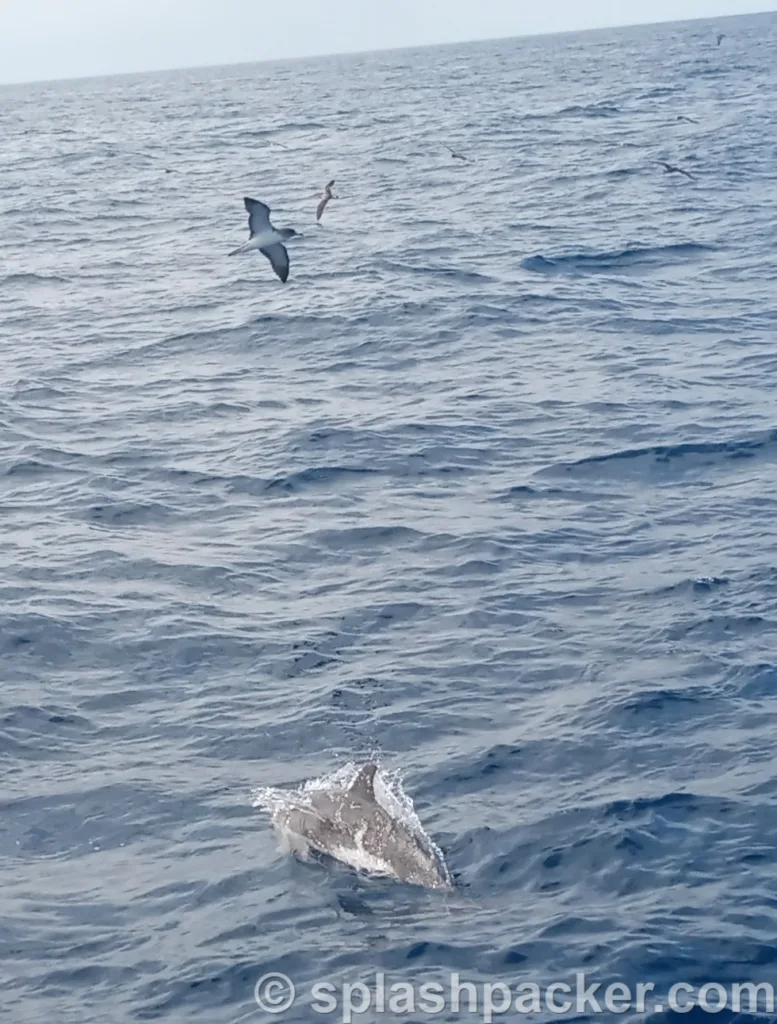
The whale and dolphin watching boats & catamarans of Gran Canaria see bottlenose dolphins almost every day
If you read any of the reviews of the excursions below, you can see that almost all reviewers leave positive comments about seeing dolphins. I also asked the guide of the company I went dolphin watching in Gran Canaria with, and she said that yes, almost every time they see dolphins. “But of course, in the ocean nothing can be guaranteed, and you have to be a bit lucky to see a whale.” And I was lucky that day, next to the most commonly seen bottlenose dolphins, we also spotted some striped dolphins and we got to see a whale too!
(I earn commission on your purchase through this advertisement)
What wild dolphin species can be seen during a dolphin tour on Gran Canaria, and in which season?
The bottlenose dolphin is seen the most during whale and dolphin watching in the Canary Islands. Both, the bottlenose dolphins and the rough-toothed dolphins, can be seen year-round in Gran Canaria. Although you have to be a bit lucky to spot the rough-toothed dolphin. The common dolphin (short-beaked), and the Atlantic spotted dolphins tend to be seen more seasonal. There might be a higher chance in the European winter months (sometimes autumn) till late spring or early summer. The striped dolphin can also be seen. Although rare, but not impossible, is the Risso’s dolphin, also called the grey dolphin.
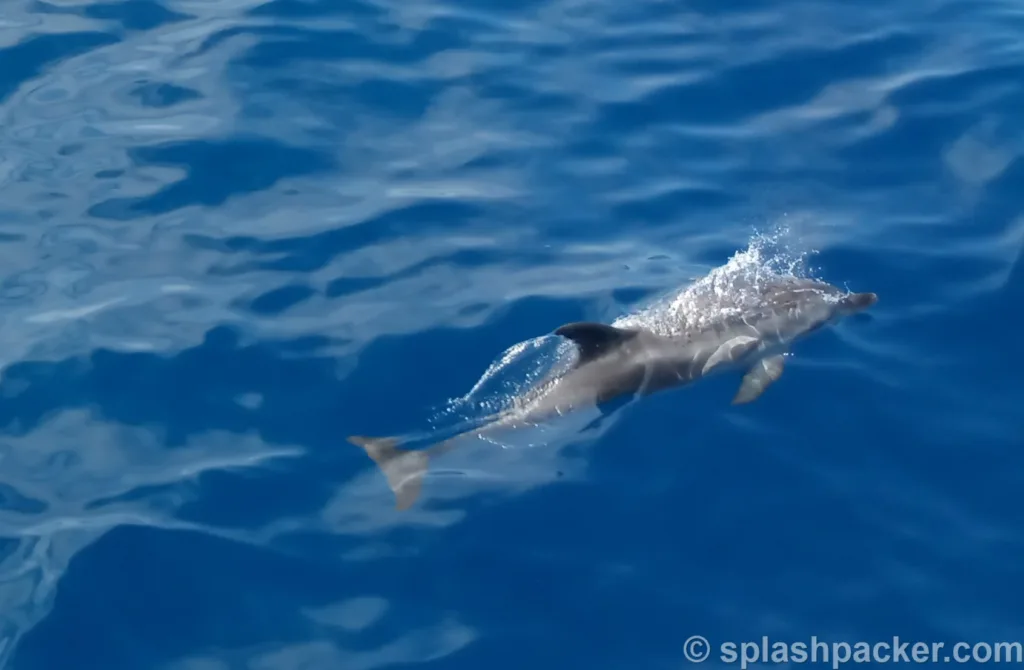
The kind of whales that can be seen during whale watching on Gran Canaria
The short-finned pilot whale, residing in the Canary waters, is the most seen whale during whale watching tours around Gran Canaria. Although less frequently, the Bryde’s whale can be seen too. Compared to all Canary Islands, the Bryde’s whale is seen most of the coast of Gran Canaria. Although not commonly spotted, there is a group of about 240 sperm whales residing in the waters of the Canary Islands, and the Blainville’s Beaked whales reside close to Tenerife. Rare, but not impossible, is to see a false killer whale and the whales on their migration route such as Sei whales, fin whales (or backfin whales), and humpback whales.
Best pick for sustainable dolphin watching on Gran Canaria: an eco-friendly company involved with marine conversation & research and offering you the dolphin guarantee!
One company, that offers a free ticket for another dolphin tour if you don’t see a dolphin or whale at all during your first boat trip, does the excursion in an impressive sustainable way (ad). They support scientific marine biology research, participate in ocean conversation projects, and are a World Cetacean Alliance member! I would definitely book the excursion with this company (see the below ad). The only thing I noticed, while reading the reviews, was some more cases of seasickness. This might have to do with the fact that it looks like they have a slightly smaller boat. Read more about minimizing the risk of seasickness towards the end of this post.
(ad)
Please note that the above company offers the dolphin cruise with or without a swim stop at the end of your dolphin tour. So check the description of the excursion and see if the total whale and dolphin watching tour takes two or three hours.
There are more environmentally responsible companies that offer the dolphin cruise on Gran Canaria
More about seasickness, with some tips, will come at the end of this blog post! But if that puts you off, I have done some research about the different boats and catamarans offering the excursion of whale and dolphin watching on Gran Canaria. And there are more responsible companies that offer the dolphin tour in an environmentally conscious and ethically responsible way. This company does a similar dolphin guarantee and also has the ‘Barco Azul’ label (ad), more about Barco Azul, or Blue Boat, later. But let’s first look at the activity of whale and dolphin watching on Gran Canaria itself, and if it’s environmentally conscious at all.
(ad)
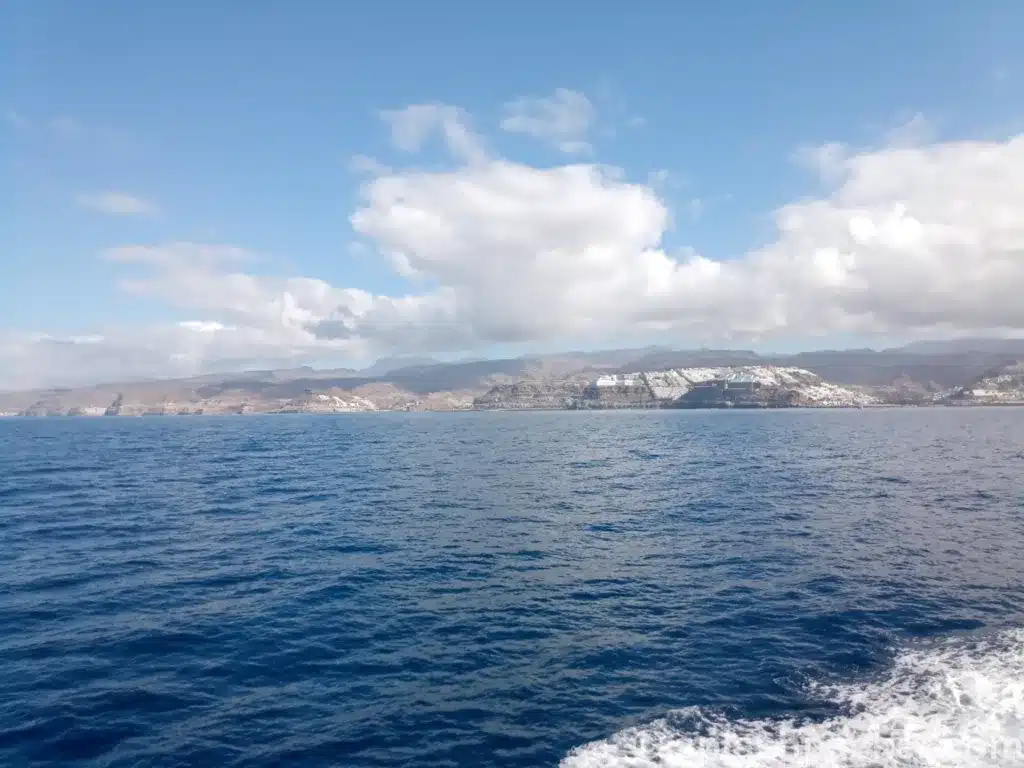
Is the marine life disturbed or negatively affected by whale & dolphin watching on Gran Canaria, is it sustainable?
As an ex-dive instructor, I wouldn’t support companies or participate in activities, that disturb marine life or disrupt fish from their natural living behavior. As scuba divers, we learn from the beginning that we should never touch marine life, feed them, leave anything in the ocean, or scare them away. So I kept that well in mind during my whale and dolphin watching excursion. They indeed leave the whales and dolphins in their natural habitat. They don’t feed them, or anything like that. I came across one interesting question on the internet regarding dolphin watching Gran Canaria:
Can you swim with the dolphins you see in Gran Canaria?
No, you can’t swim with the dolphins on Gran Canaria. Even if the dolphin excursion is sold as a ‘dolphin & swim trip’ (ad), the boat will stop for a swim closer to the island after leaving the area where the dolphins are. Observing the whales and dolphins in their natural habitat means not disturbing, feeding or stressing them. If a bunch of people jumps in the water, it would not contribute to that. So coming back to that previous question, is it ethically responsible? In my personal opinion, we didn’t disturb the dolphins. They seemed to come to the boat and enjoyed it, they jumped around and surfed our waves. But what about the whales?
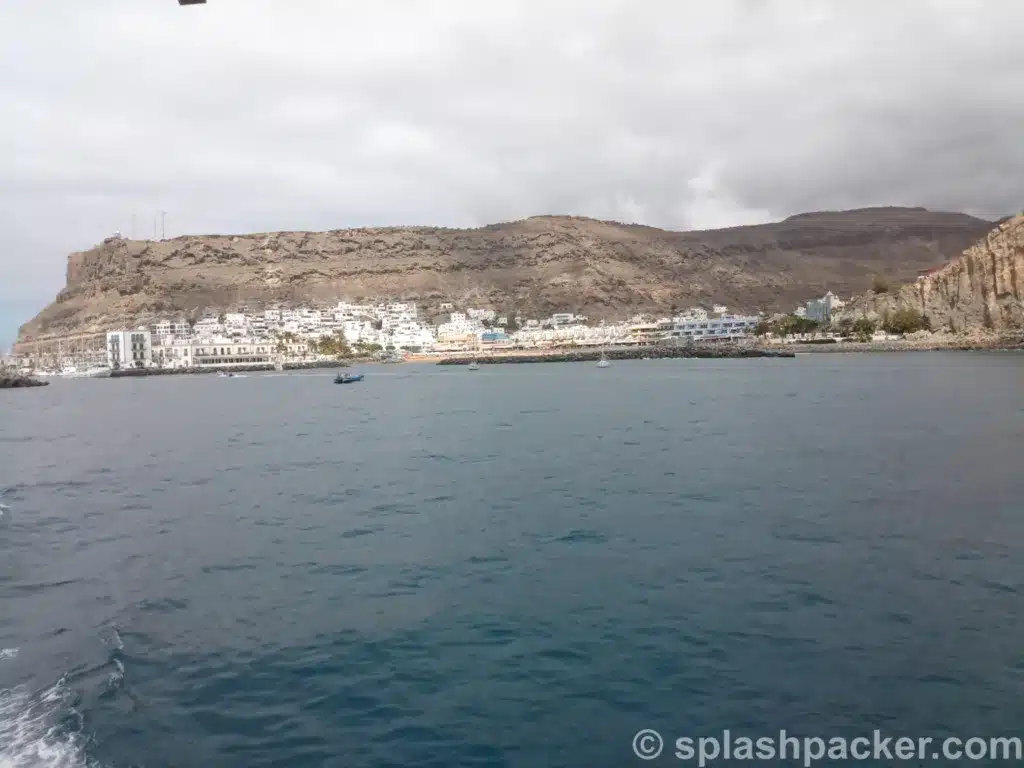
How whales are affected by whale & dolphin watching tours on Gran Canaria
Whales rely on underwater sounds to communicate, navigate, feed, and detect predators. Research by the University of Western Australia confirms that noise from a whale watch boat at a distance of 300 meters (almost 1000 feet) can still disturb them. The article continues to stress about ‘lots of boats’ as was the case in Australia. But when I went dolphin watching on Gran Canaria, there was only one other boat: a small local fishing boat. Later another whale and dolphin watching catamaran appeared, but then we soon took off. That said, the chance to see a whale is not even that big. So it’s not really to be compared to such massive activities where lots of whales live and are disturbed by those activities, as in Australia.
The question remains whether it’s an environmentally friendly activity that supports sustainable tourism on the Canary Islands
Besides offering an income for the local people, marine wildlife watching can have educational and conservational benefits if tourists are encouraged to care for the oceans and the environment. The catamaran I went dolphin watching with (ad) used reusable hard plastic cups that were washed and reused, and all drinks were served from the big water and soft drinks bottles. No throw-away cups or small bottles were used. We were not allowed to swim with the dolphins and they did not feed the animals. There were no other boats at the dolphin spot, other than the local fishing boat, as I mentioned before.
In my personal opinion, it was ethically responsible.
What you can do to go whale and dolphin watching in an eco-conscious & responsible way on the Canary Islands!
So if you’re a conscious traveler and prefer to support sustainable tourism and eco-friendly activities, you can go whale and dolphin watching on Gran Canaria. The problem is that there are many boats and catamaran tour excursions available that offer the whale and dolphin watching cruise on the island (ad). You might not know beforehand if they do it environmentally responsible, so how to choose one? Well, on the Canary Islands there is something called ‘Barco Azul’ (Blue Boat).

Barco Azul for conscious whale & dolphin watching that protects and respects the marine life of the Canary Islands
Barco Azul, meaning ‘Blue Boat’, is implemented by the government of the Canary Islands to guarantee respectful treatment and protection of marine life. The regulations imply things such as keeping a certain distance from whales, slower speeding, limiting the time spent at the place where the whales and dolphins are, and no concentrations of boats at the dolphin spot. They also prohibit touching or feeding marine wildlife, swimming with the cetaceans, or throwing anything in the ocean (obviously).
Look out for the logo or flag on your dolphin boat, or ask your dolphin tour boat staff about it. Always stay conscious of protecting marine life and keeping the ocean clean, during your dolphin tour.
(ad)
Information for your dolphin cruise on Gran Canaria: what, when & where?
Many boats for whale & dolphin watching on Gran Canaria leave from the Puerto Base harbor in Puerto Rico. There are also some boats leaving from Pasito Blanco and Puerto de Mogán. Most dolphin boat companies offer a pick-up from hotels in the touristy areas in the South of Gran Canaria. You can book the dolphin trip whole year round, and it usually takes about one morning or afternoon. Depending on the company, the total excursion time will be somewhere between 2,5 to 4 hours. The whale and dolphin watching excursion is usually done by catamaran or other boats, some with a glass bottom window.
How to book the whale & dolphin boat trip on Gran Canaria?
You can book your whale & dolphin tour, like many other excursions on Gran Canaria, with Get Your Guide (ad). The advantage of booking your tour with Get Your Guide is that you can reserve your dolphin excursion now and pay three days before your dolphin cruise date. You can also (most of the time) cancel up to 24 hours before and get your money back without any extra costs, or you can pay a bit extra to cancel up to one hour before and still get your money back. Please note that conditions might change, so make sure to check all conditions when you book, on the page itself.
(ad)
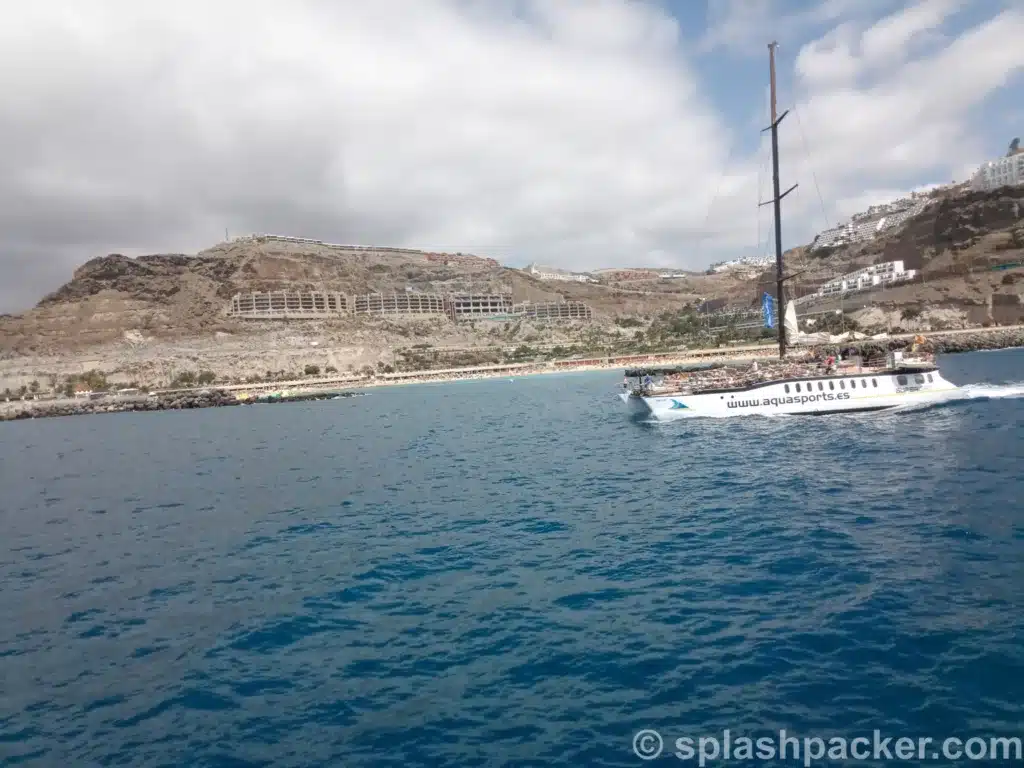
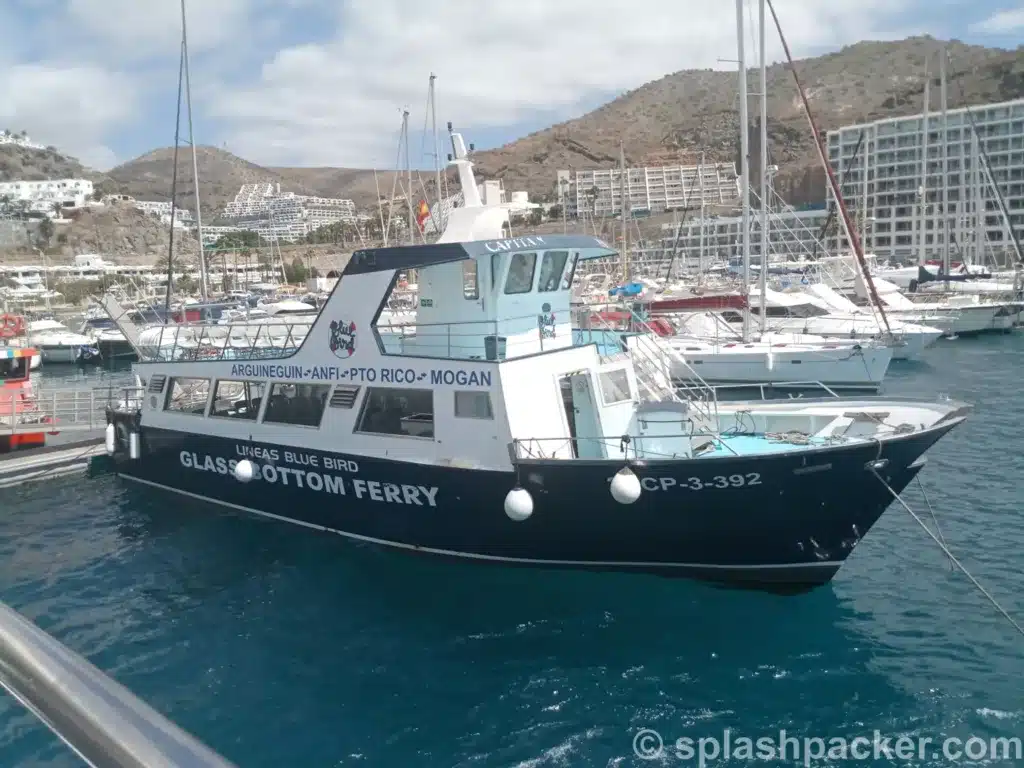
What to bring with you on the whale watching trip and dolphin excursion on Gran Canaria?
Most dolphin tour companies offer one, or unlimited, soft drink(s) for free. You probably will be back in time for lunch, but longer boat tours might offer snacks for sale or include them in their price. Bring biodegradable sun protection (ad to Amazon), a cap or hat, and sunglasses if you like to sit on the upper deck. Some dolphin watching tours on Gran Canaria include a swim stop closer to the island at the end of the excursion. So don’t forget to bring your swim clothes and a towel. Also, bring a jacket or jumper as it can get a bit chilly at sea. You might also like to bring a hair comb or brush, if you’re worried about your look after a windy boat trip.
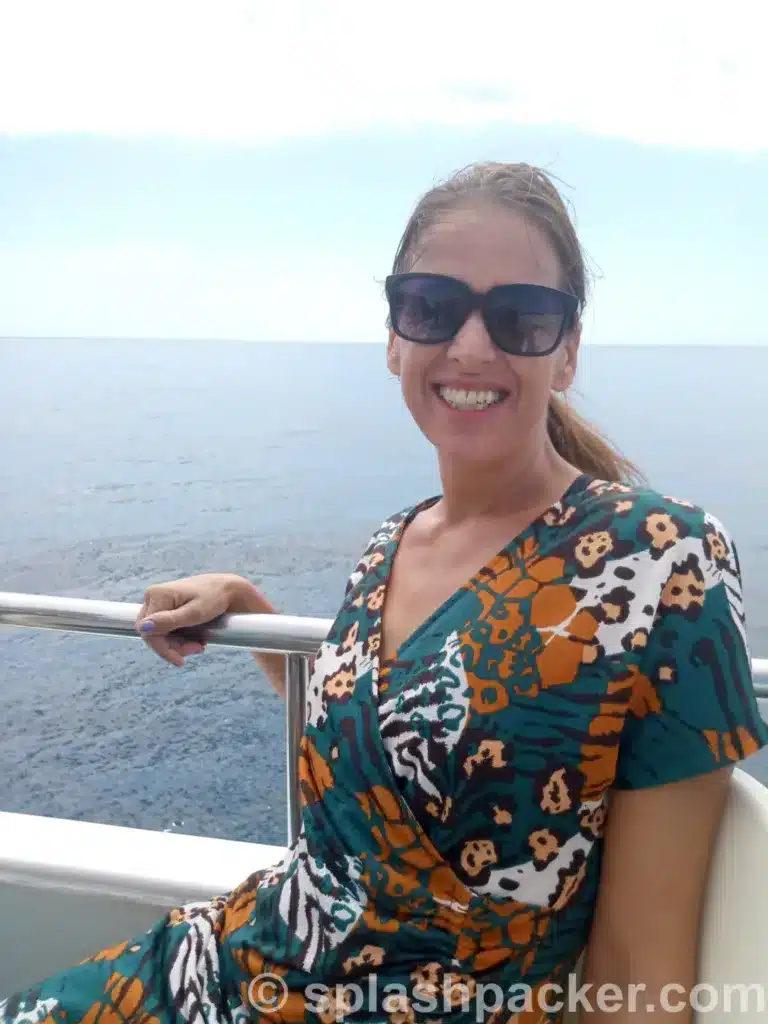
A final tip for whale & dolphin watching by boat on Gran Canaria: seasickness
If you’re prone to seasickness, keep in mind that this boat goes a bit further out at sea than most pleasure catamaran tours for snorkeling or other fun water activities, or dive boats for scuba diving. So it can get a bit wavy out there. To avoid seasickness, make sure to skip your orange juice with breakfast in the morning. You can always take some organic ginger tablets to calm your stomach. Order them here on Amazon (ad) before your holiday and take them with you. Also, the size of the boat can make a difference, at bigger boats you’re usually less likely to get sick. It also helps to do the dolphin watching excursion in the morning, rather than in the afternoon.
More travel information for Gran Canaria
If you’re looking for more travel information about the Canary Islands, and Gran Canaria in particular, please click this link for my other post. I’m currently also working on a post about staying in Arguineguín (where I find myself living currently, and also lived in 2006). In the meantime, you can use the search box on Booking (ad) for your accommodation in Gran Canaria below, use 12go.com to find your best flight deal to Gran Canaria (ad), or use this link if you prefer to book your hotel on Gran Canaria with Agoda (ad).
( I receive commission on your purchase through this ad)
Don’t expect to see a whale or dolphin during scuba diving on Gran Canaria
If you’re a scuba diver, you might want to check out my posts about scuba diving on Gran Canaria, or book your scuba diving on Gran Canaria in advanced (ad). And if you’re not a certified scuba diver yet, Gran Canaria might be a great place to do your first course. Because if you like whales and dolphins, you might love other marine life in our beautiful oceans too! Don’t expect to see a whale or dolphin during scuba diving though. Oh and by the way, did you check out my recently published post about why scuba diving is a very spiritual activity?
(ad)
Once upon a time, I saw a whale underwater during scuba diving. And a dolphin. But I was very lucky….!!
In all the years that I worked as a diving instructor around the world, I’ve seen a whale underwater only once, whilst working as a diving instructor in the Dominican Republic. And I’ve seen a dolphin once during scuba diving when I was working in the Maldives. Those two times made me feel very lucky :-) But you never know, of course, we get to be lucky at times! Especially whales usually stay away from scuba divers and their bubbles.
Want to read more about marine life, scuba diving, the Canary Islands, or my experience working as a dive instructor worldwide?
I’m a female solo traveler and working abroad since 2006. You can read more about me here. Check out this link for the book I’m writing, or sign up below for the mailing list for this website. I will also share content about sustainable tourism and eco-friendly dive travel. You can follow me on social media by scrolling down further down and also subscribe to the Splashpacker YouTube channel. For now, enjoy your whale and dolphin watching on Gran Canaria :-)
And if you’ve done the whale and dolphin watching on Gran Canaria, please share in the comments how your experience was and what whales and dolphins you saw!
Sign up for the mailing list here:
As an associate with Amazon, Get Your Guide, Booking, Agoda, and 12go, I earn from qualifying purchases through the links in this post.
(ad)
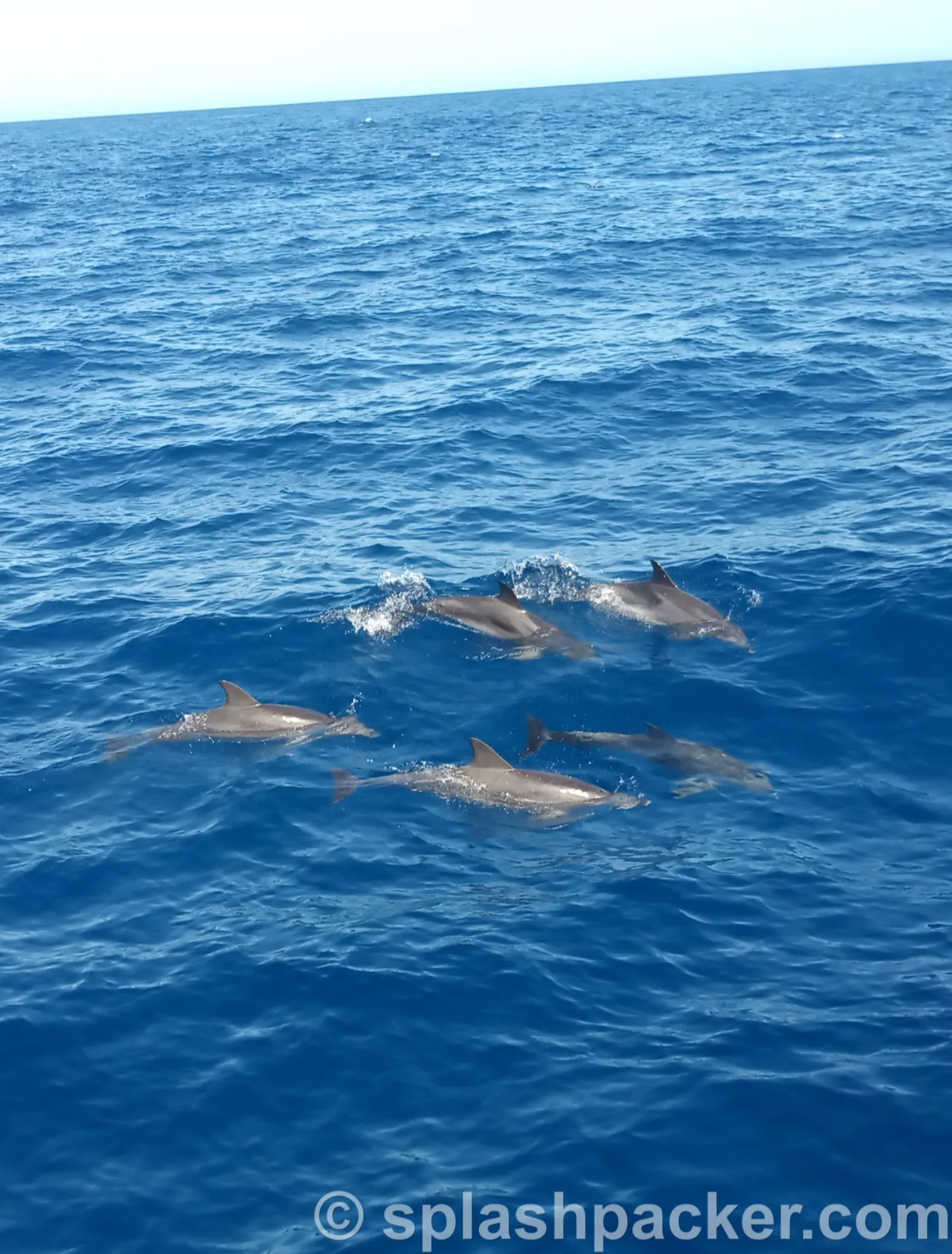
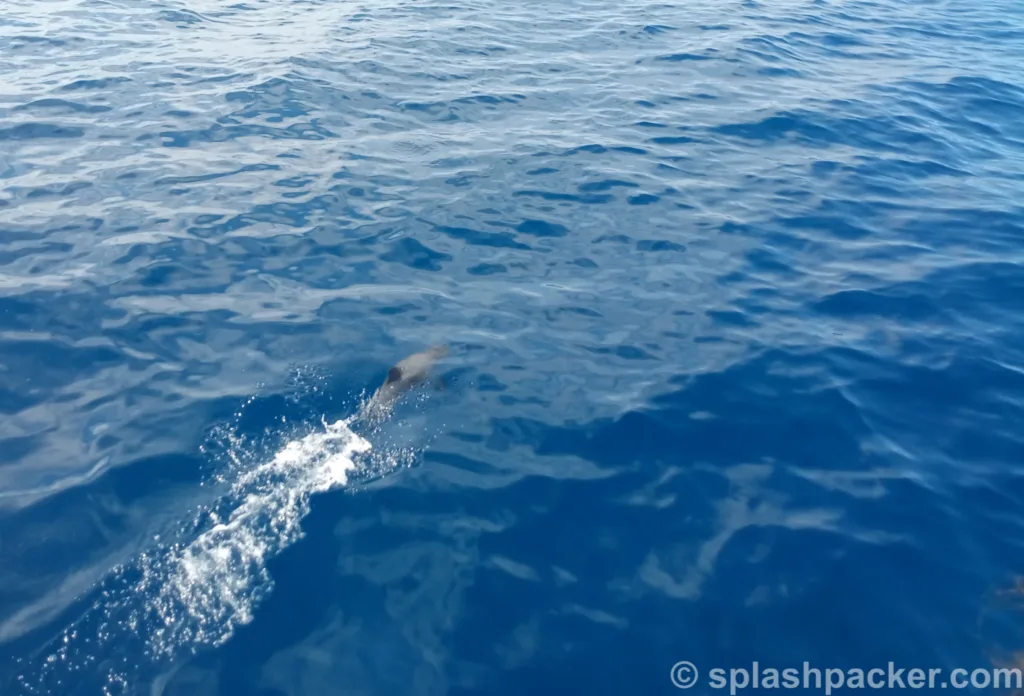
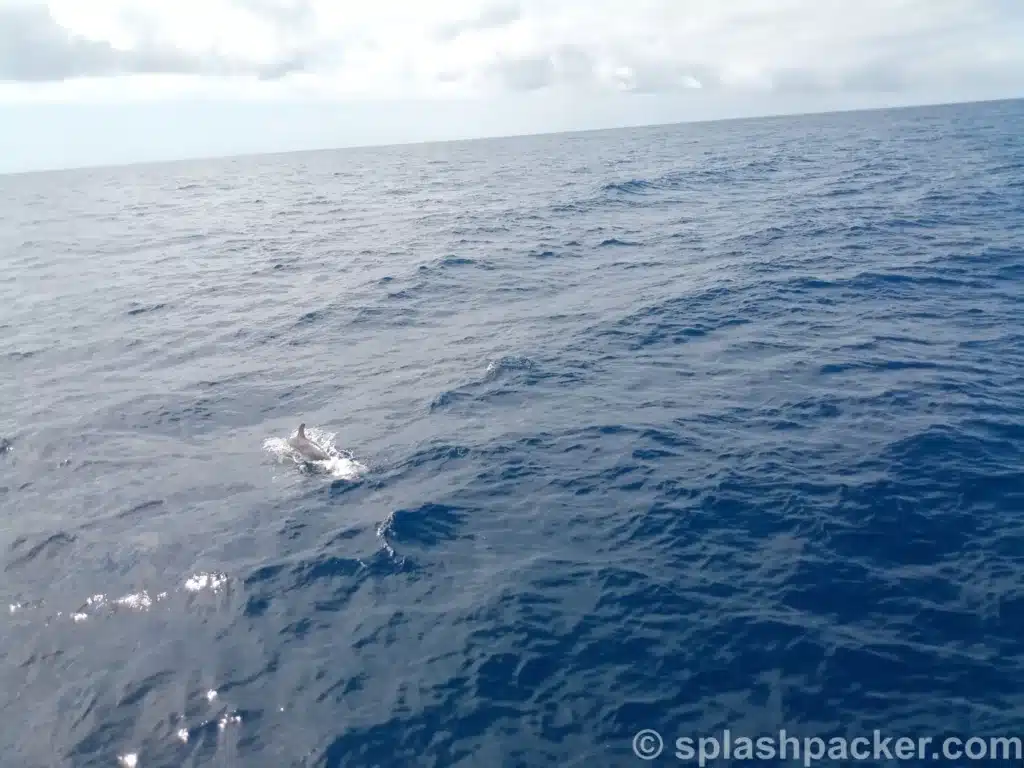
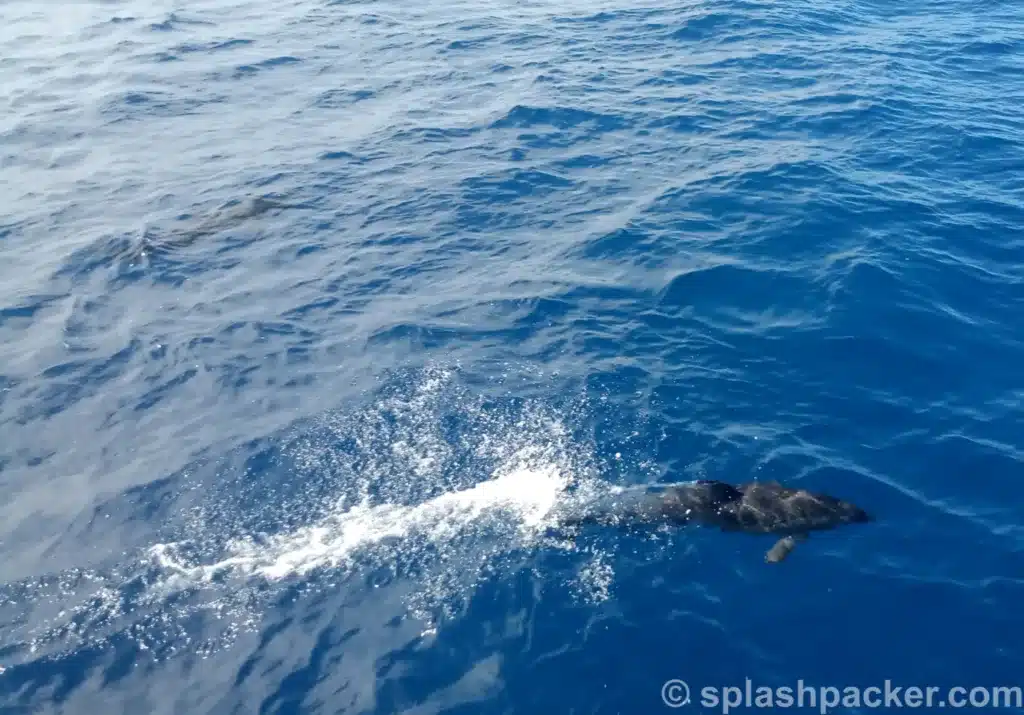
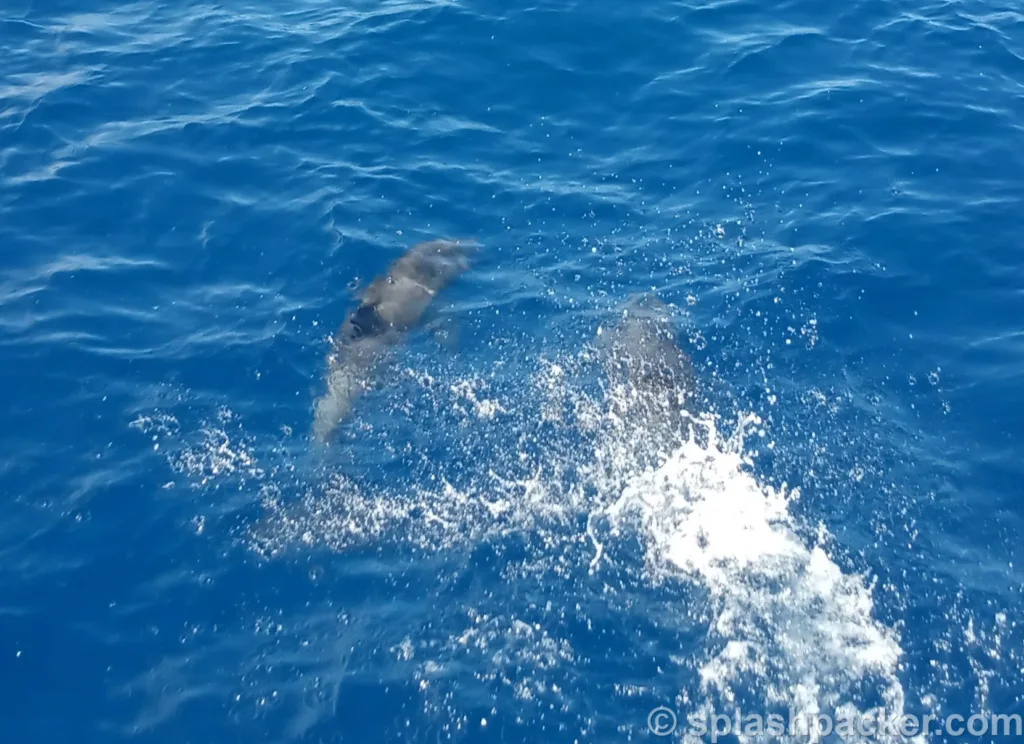
You’re more than welcome! Did you go and do the dolphin trip whilst on Gran Canaria?
Thank you Ellis for the great informations
Thank you for your comment and for being a returning website visitor :-)
I’ve been visiting this site for years, and it never fails to impress me with its fresh perspectives and wealth of knowledge. The attention to detail and commitment to quality is evident. This is a true asset for anyone seeking to learn and grow.